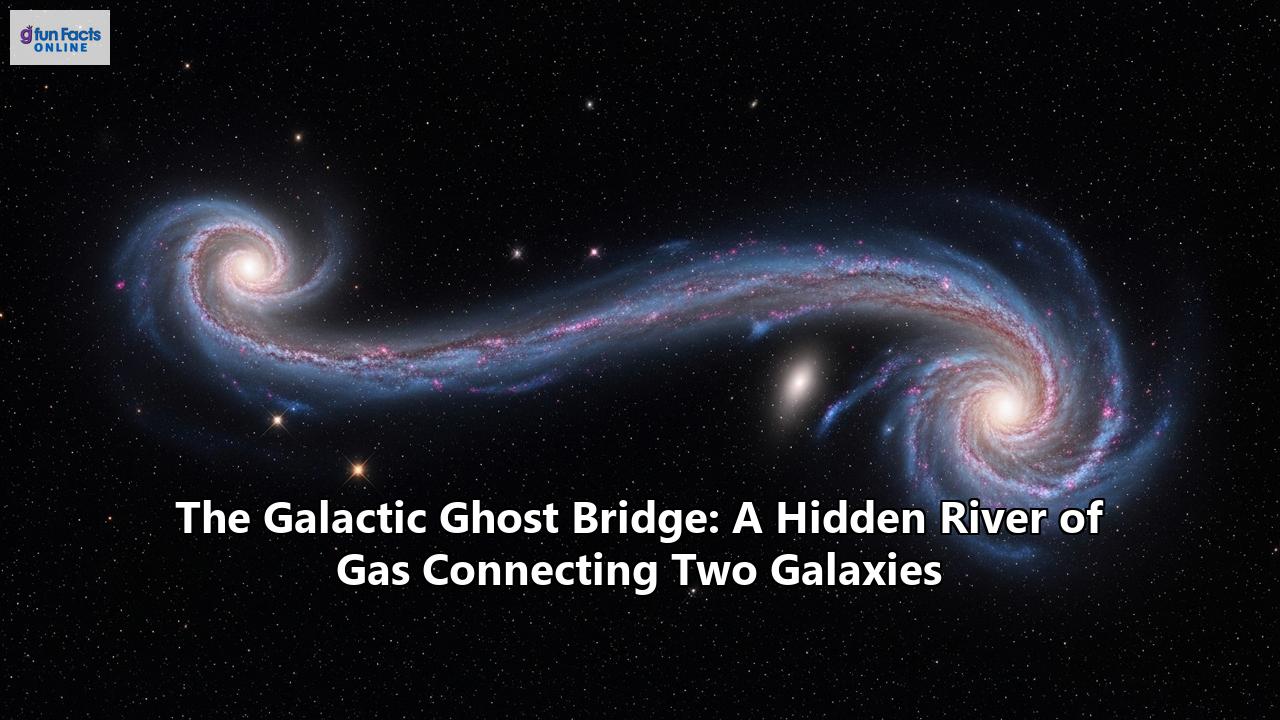In the vast, silent expanse of the cosmos, a monumental discovery has unveiled a ghostly structure of epic proportions: a colossal bridge of gas stretching between two distant galaxies. This "Galactic Ghost Bridge" is a hidden river of neutral hydrogen, offering astronomers a stunning glimpse into the dynamic and often violent interactions that shape the evolution of galaxies. The discovery not only illuminates the lifecycle of galactic matter but also provides a dramatic confirmation of the powerful forces at play in the universe.
A Bridge Between Worlds
Researchers from the International Centre for Radio Astronomy Research (ICRAR) have identified a massive stream of neutral hydrogen gas connecting two dwarf galaxies, NGC 4532 and DDO 137. Located approximately 53 million light-years from Earth within the Virgo cluster of galaxies, this cosmic bridge spans an incredible 185,000 light-years. To put this into perspective, the bridge itself is nearly twice the diameter of our own Milky Way galaxy.
This galactic link is part of an even larger and more dramatic structure. Trailing behind the two galaxies is a phenomenal tail of gas that extends for 1.6 million light-years, making it the longest such feature ever recorded. This entire system provides a unique laboratory for studying how galaxies interact with each other and their surrounding environment.
The Unseen Forces Shaping Galaxies
The formation of this immense gas bridge is not the result of a single, simple process. Instead, it's the product of a powerful cosmic duo: tidal forces and ram pressure.
Tidal Forces: Much like the Moon's gravity pulls on Earth's oceans to create tides, the gravitational pull between NGC 4532 and DDO 137 has a similar, albeit much larger, effect on the galaxies themselves. As these two galaxies orbit each other, their mutual gravity strips gas away, pulling it out into the intergalactic medium. This process is believed to have been initiated by a "close passage" or near-miss between the two galaxies more than a billion years ago. Computer modeling has shown that these tidal forces played a crucial role in the gas dynamics observed. Ram Pressure: The other major force at play is "ram pressure." As the pair of galaxies fall into the massive Virgo cluster, they are moving through a superheated cloud of gas that permeates the cluster, with temperatures reaching about 200 times hotter than the surface of the Sun. This creates a powerful wind that pushes against the galaxies, stripping away their gas in a process analogous to the atmospheric burn-up of a satellite re-entering Earth's atmosphere, but stretched over a billion years. The combination of the galaxies' speed and the density of the hot gas cloud is enough to explain why so much gas has been pulled away from the galaxies and into the bridge and the enormous tail.Peering into the Invisible
This ghostly bridge and its colossal tail are composed of neutral hydrogen gas, the fundamental building block for new stars and galaxies. This material is invisible to optical telescopes, which is why the structure remained hidden for so long.
The groundbreaking discovery was made possible by the Australian Square Kilometre Array Pathfinder (ASKAP) radio telescope, located in Australia. As part of the Widefield ASKAP L-band Legacy All-sky Survey (WALLABY), astronomers were able to map the distribution of this cold, diffuse hydrogen gas in unprecedented detail. The survey's high-resolution observations of neutral hydrogen were key to identifying the full extent of this massive structure. The radio data not only revealed the bridge and its tail but also showed that the gas disks of the two galaxies are still rotating, albeit in a messy and disturbed fashion.
Implications for Galaxy Evolution and Star Formation
The discovery of this galactic ghost bridge has profound implications for our understanding of how galaxies evolve. It provides a vivid illustration of how galaxies can lose and exchange gas, a crucial component for forming new stars.
Lead author Professor Lister Staveley-Smith of ICRAR and the University of Western Australia highlighted the importance of this finding, stating that it marks a significant step forward in understanding how galaxies interact. The stripped gas, which is no longer gravitationally bound to its parent galaxy, is drawn into the bridge, creating a vast connection between the two galaxies.
Interestingly, the gas in the bridge and its associated arms and clouds has not yet formed many stars. This offers a unique opportunity to study the conditions under which star formation might be triggered or suppressed in such a dynamic environment. Co-author and astrophysicist Professor Kenji Bekki emphasized that because neutral hydrogen plays a crucial role in the formation of stars, this finding is fundamental to understanding how galaxies interact and evolve, particularly in dense environments like galaxy clusters.
A Cosmic Echo in Our Own Backyard
This newly discovered system of a gas bridge between two galaxies bears a strong resemblance to a more familiar cosmic neighborhood: our own Milky Way and its satellite galaxies, the Large and Small Magellanic Clouds. The Magellanic Clouds are also connected by a bridge of gas and have a long, trailing stream of hydrogen gas known as the Magellanic Stream, which was also formed by tidal forces and ram pressure from the Milky Way's hot halo. The NGC 4532 and DDO 137 system appears to be a larger and faster version of what is happening in our own galactic vicinity. Studying this distant bridge can, therefore, provide crucial insights into the past and future of the Milky Way and its companions.
The "Galactic Ghost Bridge" is a testament to the dynamic and ever-changing nature of the universe. It reminds us that galaxies are not static islands of stars but are constantly interacting, exchanging material, and evolving over billions of years. This spectacular and previously hidden structure serves as a powerful reminder of the unseen cosmic forces that continue to shape the universe around us.
Reference:
- https://scitechdaily.com/astronomers-discover-colossal-cosmic-bridge-linking-galaxies-across-space/
- https://www.sciencedaily.com/releases/2025/10/251018102126.htm
- https://dailygalaxy.com/2025/10/astronomers-universes-largest-bridge/
- https://www.livescience.com/space/astronomy/astronomers-spot-giant-hidden-bridge-and-record-breaking-tail-between-2-dwarf-galaxies
- https://wallaby-survey.org/2025/09/24/dwarf-galaxies-linked-by-massive-intergalactic-gas-bridge/
- https://shiawaves.com/english/news/science/135805-massive-gas-bridge-discovered-linking-two-galaxies/
- https://www.discovermagazine.com/these-dwarf-galaxies-are-joined-by-an-intergalactic-bridge-tens-of-thousands-of-light-years-long-48082
- https://www.earth.com/news/two-galaxies-found-to-be-linked-by-an-astonishingly-massive-gas-bridge-the-longest-such-structure-ever-seen/
- https://www.lco.cl/a-mysterious-river-of-gas-flowing-into-the-milky-way-galaxy/
- https://www.space.com/stars-discovered-in-magellanic-stream-first-time

